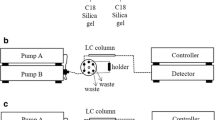Abstract
The aim of this study was to determine whether an ingested drug and its metabolites could be detected in the subject’s fingerprints. Caffeine (CF) was chosen as the model drug. Three healthy subjects were asked to consume a cup of coffee (ca. 100 mL) containing 80 micro micro mg CF as the total dose, which is the normal amount in one cup of coffee. After washing hands with water to remove external contaminants, each subject pressed the index fingertip to a collecting matrix just before consuming the test cup of coffee, and then again pressed the index fingertip to the collecting matrix after 1, 3, 5, and 7 h. The time curve of the amounts of CF and its metabolites—theobromine (TB), paraxanthine (PX), and theophylline (TP)—in fingerprints and blood was determined using liquid chromatography/tandem mass spectrometry (LC/MS). A filter paper wetted with water (50 μL) was an efficient collecting matrix for extracting the analytes from the fingertip. With optimized sample preparation and LC/MS conditions, the total operating time, from taking the fingerprints to obtaining the analytical result, was approximately 10 min. The lower limits of quantification for CF, TB, PX, and TP were 0.5, 5, 0.5, and 5 ng/fingerprint, respectively. The amount of CF or PX determined in fingerprints obtained over 7 h after coffee intake was significantly greater than the amount determined in fingerprints taken before drinking coffee. Fingerprints were a more efficient source for drug testing than other biological samples, such as blood and sweat, because the procedures for sampling and extracting the drugs were simpler and took less time. The method could be used to prove drug intake in criminal investigations.





Similar content being viewed by others
References
Faulds H (1880) Nature 22:605
Faulds H (1894) Nature 50:548
Herschel WJ (1894) Nature 51:77–78
Galton F (1892) Finger prints. Macmillan, London
Lee HC, Gaensslen R (2001) Advances in fingerprint technology. CRC Press, Boca Raton
Bush DM (2008) Forensic Sci Int 174:111–119
Barnes AJ, Smith ML, Kacinko SL, Schwilke EW, Cone EJ, Moolchan ET, Huestis MA (2008) Clin Chem 54:172–180
Rowell F, Hudson K, Seviour J (2009) Analyst 134:701–707
Ng PH, Walker S, Tahtouh M (2009) Anal Bioanal Chem 394:2039–2048
Hazarika P, Jickells SM, Russell DA (2009) Analyst 134:93–96
Lee D, Milman G, Schwope DM, Barnes AJ, Gorelick DA, Huestis MA (2012) Clin Chem 58:1101–1109
Coulter C, Garnier M, Moore C (2012) J Anal Toxicol 36:413–417
Stavric B, Klassen R, Watkinson B, Karpinski K, Stapley R, Fried P (1988) Food Chem Toxicol 26:111–118
US Food and Drug Administration (2007) Medicines in my home: caffeine and your body. US Food and Drug Administration, Silver Spring
Tang-Liu DD, Williams RL, Riegelman S (1983) J Pharmacol Exp Ther 224:180–185
Lelo A, Miners JO, Robson R, Birkett DJ (1986) Clin Pharmacol Ther 39:54–59
Kumazawa T, Sato K, Seno H, Ishii A, Suzuki O (1994) Forensic Sci Int 68:53–67
Regal KA, Howald WN, Peter RM, Gartner CA, Kunze KL, Nelson SD (1998) J Chromatogr B: Biomed Sci Appl 708:75–85
Muir KT, Kunitani M, Riegelman S (1982) J Chromatogr 231:73–82
Naline E, Flouvat B, Advenier C, Pays M (1987) J Chromatogr 419:177–189
Tanaka E (1992) J Chromatogr 575:311–314
Kizu J, Watanabe S, Yasuno N, Arakawa Y, Uzu S, Kanda S, Komoda F, Iwata T, Hayakawa H, Hayakawa T, Imai K (1999) Biomed Chromatogr 13:15–23
Kanazawa H, Atsumi R, Matsushima Y, Kizu J (2000) J Chromatogr A 870:87–96
US Food and Drug Administration (2001) Guidance for industry bioanalytical method validation. US Food and Drug Administration, Rockville
Momoh P, Fandino A, Aisawa E, Schlabach T, Miller K, Stafford G (2010) Technical overview: ifunnel technology for enhanced sensitivity in tandem LC/MS. Agilent Technologies, Inc, Santa Clara
Romanelli A, Olson L, Biesenthal T, Ghobarah H (2012) Technical note: the AB SCIEX Triple Quad™ 6500 system for bioanalysis—a new level of sensitivity. AB SCIEX, Framingham
Acknowledgment
This work was supported in part by a Grant-in-Aid for Young Scientists (B) (24790649) from Japan Society for the Promotion of Science.
Author information
Authors and Affiliations
Corresponding author
Additional information
Published in the special paper collection Forensic Toxicology with guest editors Kazuhito Watanabe and Satoshi Chinaka.
Rights and permissions
About this article
Cite this article
Kuwayama, K., Tsujikawa, K., Miyaguchi, H. et al. Time-course measurements of caffeine and its metabolites extracted from fingertips after coffee intake: a preliminary study for the detection of drugs from fingerprints. Anal Bioanal Chem 405, 3945–3952 (2013). https://doi.org/10.1007/s00216-012-6569-3
Received:
Revised:
Accepted:
Published:
Issue Date:
DOI: https://doi.org/10.1007/s00216-012-6569-3




